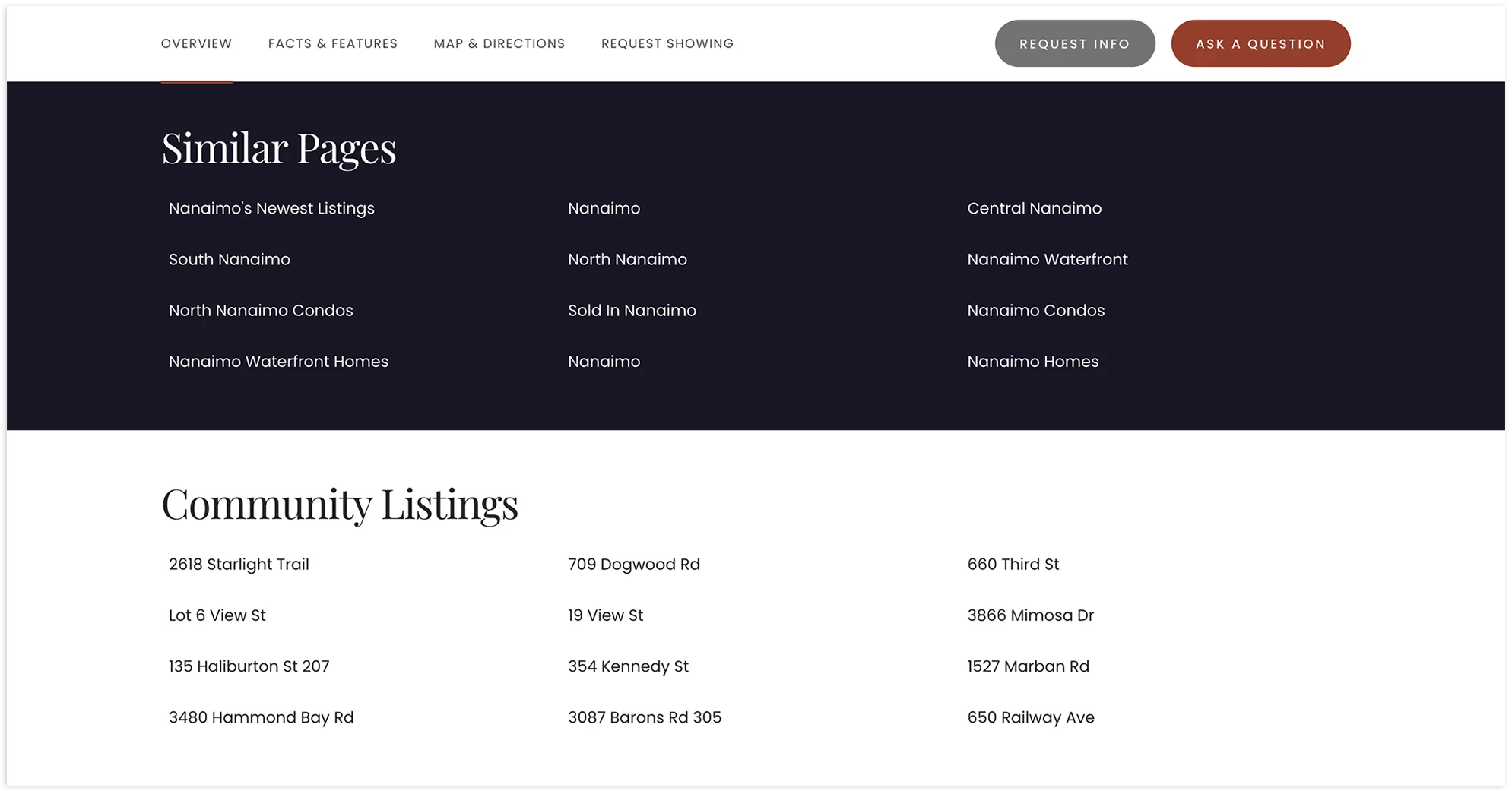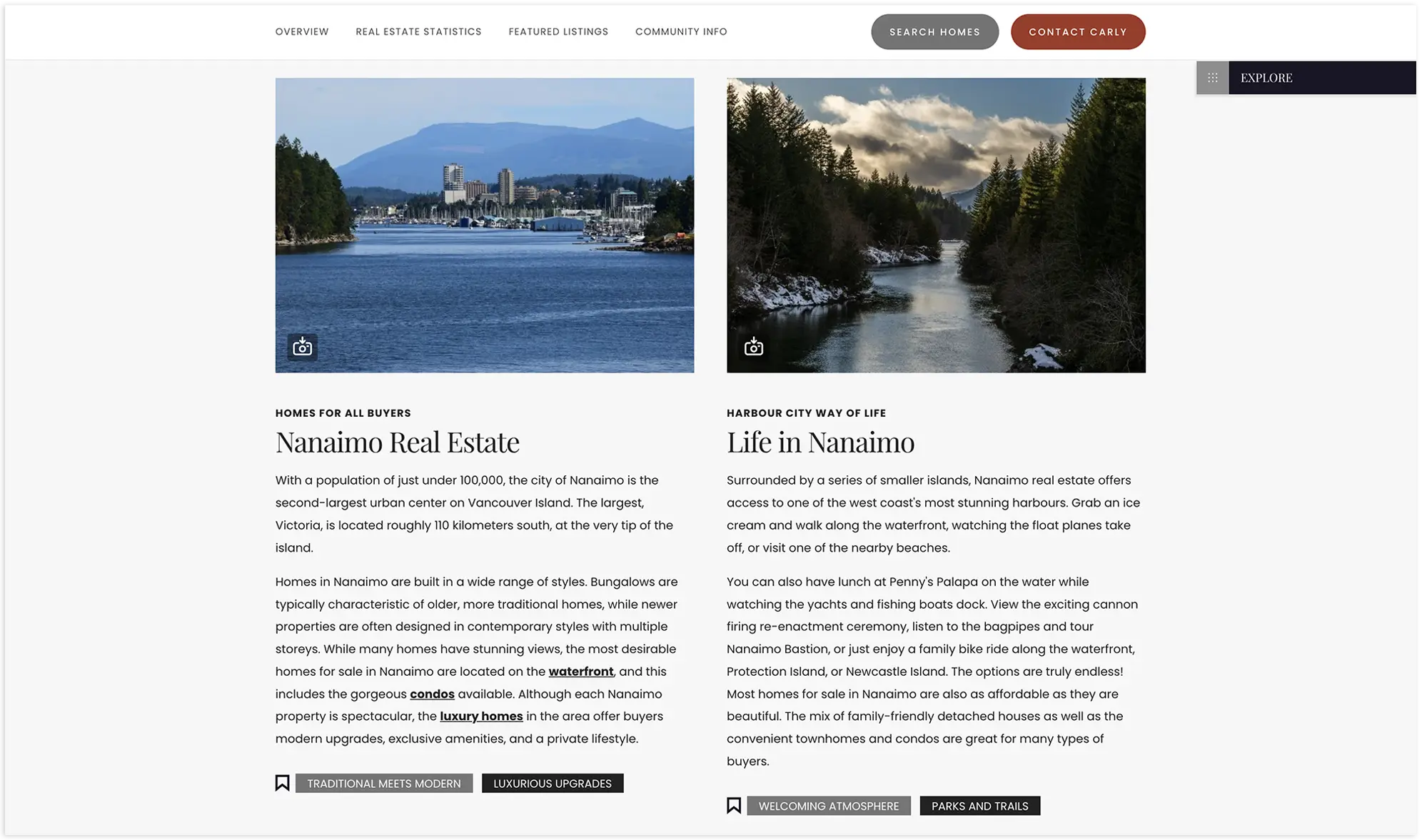A Simple Way to Boost Your SEO: Internal Dynamic Linking
Internal linking might not be the first thing to pop into mind when it comes to SEO, but it’s one of the most important aspects of it. Internal linking talks about connecting one page of your site to another, and those connections help search engines understand your site, build your authority, and prompt visitors to explore your website.
For real estate agents, this is especially important. Prospective leads usually jump between listings, neighborhood pages, blogs, and guides before deciding to reach out. Strong internal linking keeps them engaged and points them toward the pages that are relevant to them. At Real Estate Webmasters, we publish thought leadership content like this to support agents who want to learn SEO, and internal linking is an essential topic to cover.

Internal linking of related properties on a listing page.
Table of Contents
Why Internal Linking Matters
Internal links are an efficient way to connect related pages. If not done properly, people and search engines can get lost. Good linking makes your website easier to navigate, and tells search engines which pages are most important. That means your community guides, listing pages, or agent profiles can get visibility instead of being buried.
Plus, internal linking boosts your website's authority by promoting link equity, which is the value a receiving page gets from other pages through hyperlinks. This can be achieved through traditional or dynamic internal links, which are both used by Real Estate Webmasters.
Dynamic vs. Traditional Internal Linking
Traditional linking is manual. You write a blog post or content on one of your pages, and add anchor texts (clickable words or phrases that act as a hyperlink) to lead you to another page. Dynamic linking takes that same idea and automates it. Instead of manually adding links, the system uses tags to automatically feature related blogs, forum posts, or content. The connections update on their own, so you're sure that your page shows the latest articles or posts.

The tagging system on the backend of blog posts.
Our Dynamic Tagging System
Real Estate Webmasters' website is built to be the most SEO-friendly platform in the industry, and we intentionally use internal linking to strengthen our on-page SEO. With innovation as one of our core values, it is not surprising that we took our internal linking even further. Our team developed a dynamic tagging system for our site that uses the tags we already apply in blogs and forums to connect it with other pages. If a page is about SEO, the system automatically searches other SEO-related posts or discussions and displays them on the page. We can even set how many posts show up, whether images are included, and how the layout looks. It keeps things organized and more engaging to site visitors.
Right now, you’ll see it working on our own SEO, PPC, and REW CRM pages. Feel free to check them out! You can also read our dynamic linking forum post to learn how we created this.

Real Estate Webmasters' forum and blog posts dynamically linked to the SEO page.
Supporting SEO Content Pillars
Dynamic linking fits perfectly with our SEO content pillar strategy, which uses a pillar page and sub pages. A pillar page is your “big topic” page (for example, “real estate SEO”), and your subpages support it with related topics like “how to improve SEO in real estate” or “best real estate SEO practices.” Make sure that keywords in subpages align with the main page's chosen keyword. We also recommend utilizing the category section on your pages and adding schema markup so search engines can better understand your site structure and content.
The pillar page benefits from the SEO content pillar strategy because supporting content is directed back to it, making the pillar page stronger in search results. Subpages can also rank independently for specific keywords, which boosts the overall visibility of your website. Dynamic linking makes this process simpler, since related content is automatically pulled together without needing someone to manually connect the pages.

Image of Real Estate Webmasters' advanced SEO Pillar Structure.
Applying Dynamic Linking to Listings
We all know how important your listings pages are, but they often lack unique content and link equity. This can make it difficult for listings to rank in search engine results pages. With dynamic linking, you can easily connect a listing to related blog posts or discussions, solving this issue. For example, a waterfront listing page could automatically display posts about waterfront living or points of interests, making your listings page more engaging, helpful, and valuable.

Dynamic linking using blog post tags on a Nanaimo community page.
Benefits of Internal Linking
Dynamic and traditional internal linking has many benefits:
- Improves your SEO performance – Internal linking builds authority and helps search engine bots to index your content, which increases your pages' discoverability. The tags used for dynamic linking also act as keywords, giving better context to your main page. If you're using traditional linking, make sure to use descriptive words as your anchor texts, and link to deep pages.
- Better user experience – Internal links guide site visitors to the content they're searching for, and they’re encouraged to keep exploring. This is beneficial because the longer they stay, the more likely they will convert.
- Saves you time – If you've been writing content for a while now, then you probably have some blogs or articles that you already forgot about. Totally understandable! With dynamic internal linking, you don't have to think too hard about which related content you should link to your page. This is done automatically, eliminating the need to recall past content and manually link them.
Using both traditional and dynamic linking will help improve your website’s online presence, increase engagement, and convert visitors to leads. But before overly focusing on internal linking, remember to create great, helpful content that showcases your expertise and knowledge. Without this, all your efforts to rank will be wasted. Check out our CEO, Morgan Carey's, REW Forum post to learn more about why you should do this.

Long tail keyword results after improving keyword citations.
Learn More About SEO
SEO is a hot topic for many real estate professionals, and we understand why. To help you boost your SEO skills and knowledge, we created the Resources page so you can easily access all our SEO blogs and articles. We also have SEO video tutorials and webinars on REW Academy so you can learn from experts. Don’t hesitate to bookmark these pages if you want to try your hand at doing SEO for your website.
Alternatively, feel free to contact us if you prefer to work with our professional SEO team to improve your website visibility.
Dynamic Linking FAQ
What is the significance of internal linking in SEO?
Internal linking is crucial for SEO as it establishes connections between different pages within a website, ensuring content is easily crawlable and indexable by search engine bots. This contributes to improved search engine rankings and enhances site navigation.
How does Real Estate Webmasters use dynamic linking in their website?
Real Estate Webmasters utilizes a dynamic tagging system, seamlessly embedding forum and blog posts within CMS pages. This system allows for controlled display of related posts, which enhances user experience.
How does dynamic internal linking support the SEO content pillar strategy?
Dynamic internal linking supports the SEO content pillar strategy by strategically linking a main pillar page from subpages, listings pages, and real estate blogs. This enhances overall SEO performance and builds authority around the chosen keyword on the main page.
How can dynamic linking transform listing pages?
Implementing dynamic internal linking in listings connects them with relevant blog posts and content, transforming the listings page into a more appealing and helpful resource for visitors. This approach can significantly impact lead generation and conversions.
